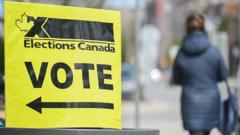As Canada braces for a pivotal federal election, the Greater Toronto Area emerges as a battleground. With the Conservative Party gaining traction due to economic factors, including rising costs and U.S. tariffs, the outcome in this key region may determine the future leadership of the country.**
Key Factors in Canada's Upcoming Election: The Greater Toronto Impact**

Key Factors in Canada's Upcoming Election: The Greater Toronto Impact**
The Greater Toronto Area could play a decisive role in shaping Canada's political landscape amidst rising voter dissatisfaction.**
In the lead-up to Canada's federal election, the Greater Toronto Area (GTA) has become a focal point that could significantly influence the outcome. Traditionally a stronghold for the Liberal Party, recent shifts in voter sentiment have raised concerns for Prime Minister Mark Carney and his party. The Conservatives have successfully penetrated this crucial region, which houses approximately 7 million residents, largely due to growing dissatisfaction over rising housing and food prices.
The turning point came when the Liberals suffered an unexpected defeat in a special election in downtown Toronto, a seat held for 28 years by a prominent member of the party. This loss not only highlighted the waning support for the Liberals but also sparked fears of broader implications for the upcoming general election, prompting Prime Minister Trudeau’s eventual resignation.
As all 343 seats in the House of Commons are contested, the 56 from the GTA will likely be decisive. With the backdrop of President Trump's recent tariffs impacting trade relations, candidates Mark Carney and Conservative leader Pierre Poilievre are gearing up for a fierce competition. As economic pressures mount, voter focus on these issues suggests that the battle for the GTA may very well dictate who will lead the nation through challenging times.





















